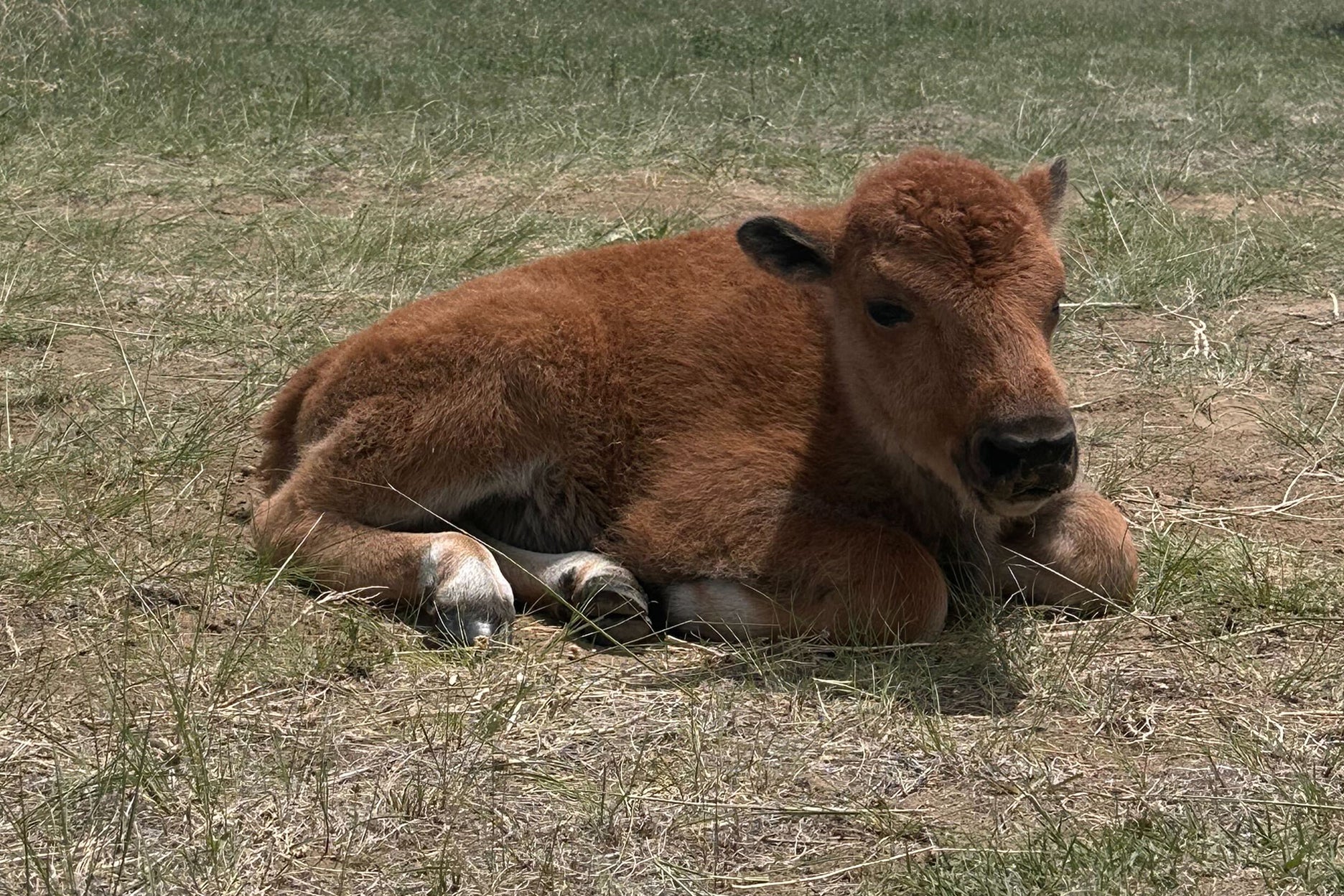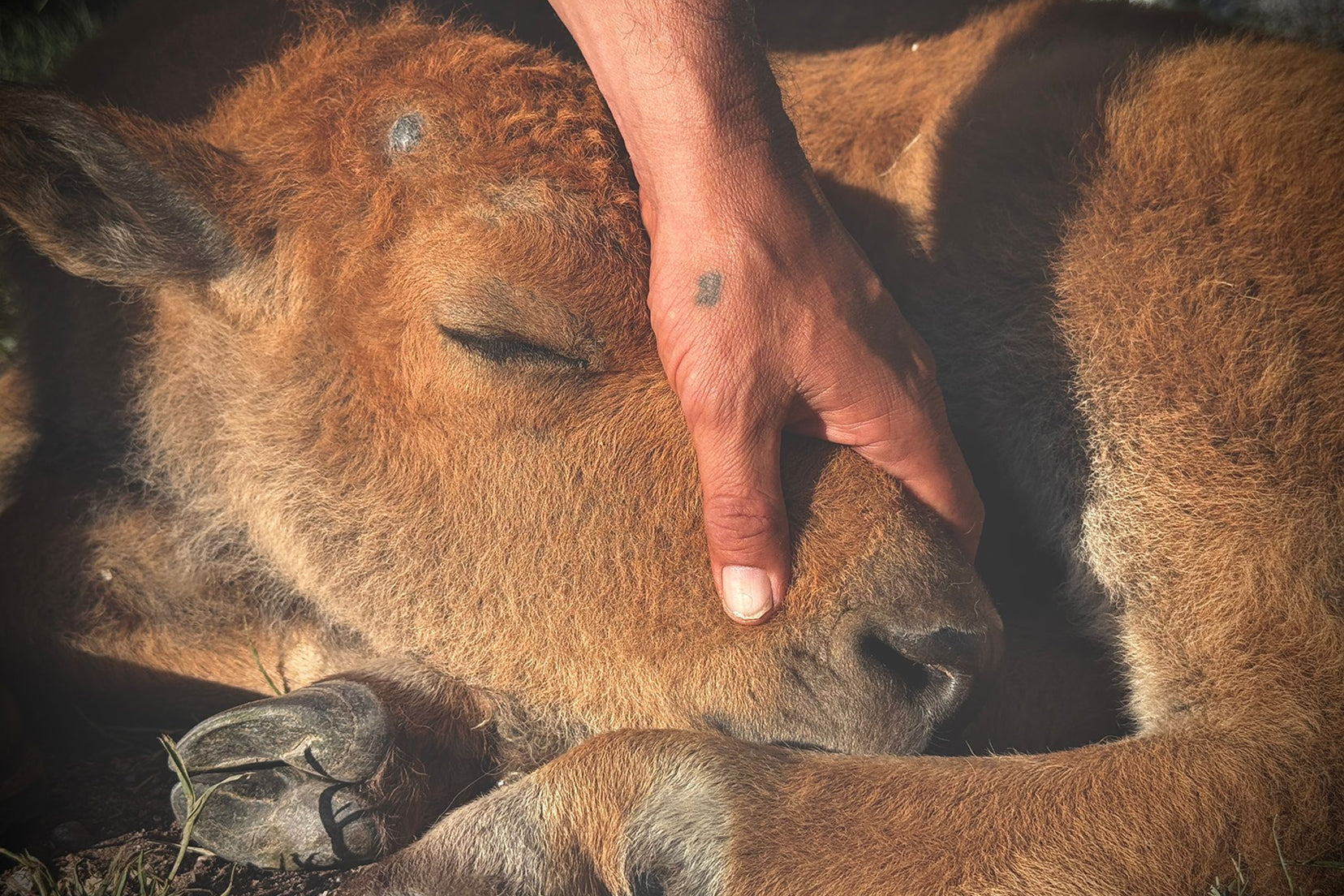
Ruby Red was found near a fence line in early Summer as the grass started to green. The air was gradually warming from months of harsh winter and the baby Buffalo was left alone, unable–or unwilling–to get up. We suspect Ruby’s mother had twins and was simply unable to care for both calves. So she was scooped up, fed and looked after by members of the Wind River Tribal Buffalo Initiative (WRTBI), and is now preparing to rejoin the herd. As she grew over the weeks, her horns started to peak out from under her ginger hair. She began to darken around the eyes and turn those iconic deep earth tones. She was growing up into the iconic visage of the Buffalo.
Ruby Red was found near a fence line in early Summer as the grass started to green. The air was gradually warming from months of harsh winter and the baby Buffalo was left alone, unable–or unwilling–to get up. We suspect Ruby’s mother had twins and was simply unable to care for both calves. So she was scooped up, fed and looked after by members of the Wind River Tribal Buffalo Initiative (WRTBI), and is now preparing to rejoin the herd. As she grew over the weeks, her horns started to peak out from under her ginger hair. She began to darken around the eyes and turn those iconic deep earth tones. She was growing up into the iconic visage of the Buffalo.
The power Ruby has to establish a lifelong bond between Buffalo and tribal members is important to WRTBI’s mission—the re-establishment of the connection between the Buffalo and the local Eastern Shoshone and Northern Arapaho tribes. As founder and executive director Jason Baldes (Eastern Shoshone) played surrogate mother to Ruby she was introduced to the people who have visited our corner of the world in the past few months. From dozens of young Indigenous students during a conservation camp, to local tribal leaders, and people who had never seen a Buffalo before. The tribal relationship between human and Buffalo was intentionally severed by the United States eradication policies throughout the 19th century, in large part to disrupt the cultural, economic, and spiritual relationship between Indigenous peoples and the Buffalo, and to force tribes onto reservations—we at WRTBI are fixing that, one Buffalo at a time.
Ruby Red connects tribal members and non-Natives to the importance of the Buffalo’s reintroduction to the land where they once roamed in the millions. She is wildlife and her place is with other Buffalo on the plains of sagebrush where the Wind River feeds the local plants and animals. She has endeared herself to the community—and to us here at WRTBI—but our focus is how to help her join the herd and to respect her autonomy as our relative.
As someone who is both Arapaho and Shoshone, and works at WRTBI, being able to spend time with Ruby has been especially meaningful to me. Right now on the property, the Eastern Shoshone has around 130 Buffalo on around 2,000 acres of land on the Wind River Reservation, located in central Wyoming. Students from the local schools of the region's reservations come to WRTBI to learn about how to protect our land and water. Presentations from representatives at state parks, tribal offices, and conservation organizations impress upon the young minds how important the future is and how difficult it will be to save it. Due to climate change and challenges to tribal sovereignty, the future of wildlife conservation and cultural restoration hangs in the balance.
While everyone at the camp did an admirable job emphasizing the importance of working in conservation, nothing really beats the lessons provided by a baby Buffalo. Ruby spun around, drank milk, and napped as the students looked at her like she was magic. I admit, she charmed me as well as I got to know her better. As an adult it’s easy to separate yourself from the beauty of the animals and plants. From a kids perspective they are so transfixing, but I’ve found as I’ve gotten older that I understand animals less than when I was growing up. Being around the future leaders of the Northern Arapaho and Eastern Shoshone tribes and watching their excitement bloom in the Spring alongside the sage was beautiful.
Adding to the compelling scene was a newborn colt named Sand Dune, born just a few days after Ruby Red. Sand Dune was also an orphan and was being nursed from a bottle until he became an adult. His head and three of his feet had touches of white against his reddish-brown coat, very similar to the coloring of Ruby Red. Baby Buffalo are often called Red Dogs for their red coats, wagging tails, and panting faces. Sand Dune also represents a big part of our work at WRTBI, as the Shoshone and Arapaho are horse peoples—we have a long and sacred history with our long-legged companions. My heart warmed at the sight of Ruby and Sand Dune together, often playing or in quiet contemplation next to each other.
As I looked at the students asking questions about Ruby Red and Sand Dune—like how to protect them, care for them, and steward their habitat—I was compelled to dream of a future where horse, Buffalo, and our youth are centered. Where policy and land management decisions are made with these three groups at the center, instead of the periphery.
It was a beautiful idyllic vision of the future where we connect more and more students with their cultural roots by being on the land and forming relationships with the plants and animals here on the Wind River Reservation. Ruby Red and Sand Dune are both powerful tools to connect all who visit us at WRTBI to our vision: cultural revitalization realized by putting Buffalo back on the Wind River Reservation as wildlife.
“Wildlife” is a legal distinction and what species are considered wildlife is a matter of debate. Buffalo, like Elk, can be put on a ranch, depending on the laws of a particular state, despite being in their native habitat. According to the National Park Service, there are approximately 500,000 Buffalo that are privately owned and raised for commercial purposes, such as meat production. A much smaller number, around 31,000, are managed as wildlife in conservation herds and publicly owned herds, including bison in national parks and wildlife refuges. Here in Wyoming, the Eastern Shoshone just voted to make Buffalo a wildlife species on tribal land as opposed to a domesticated livestock species like cattle.
So, while Ruby Red’s giant brown eyes, tiny horns, and tail waggles are incredibly adorable, she does not belong to us here at WRTBI. She belongs to the Eastern Shoshone tribe and our community here as an autonomous being with a sovereignty of her own that we as Indigenous Peoples must respect. If we were to keep Ruby Red as a pet or mascot, we would be in direct violation of our goals as an organization. She’s wildlife, not livestock, an important difference in our organization's views on animals.
While we saved Ruby from starvation, and are currently nursing her back to health, she has always been destined to rejoin the herd where she will become unrecognizable—growing to a huge 2,000 pound Buffalo and blending back in with the herd, becoming indistinguishable from other female Buffalo. The ultimate goal is for her to live and play and love on the land as a free animal, like her kind did for thousands of years before settlers almost wiped them from the Earth. We at WRTBI are here to serve Ruby and her herd.

WRITTEN BY Taylar Dawn Stagner, Community Engagement Director—Wind River Tribal Buffalo Initiative
#Stewardship